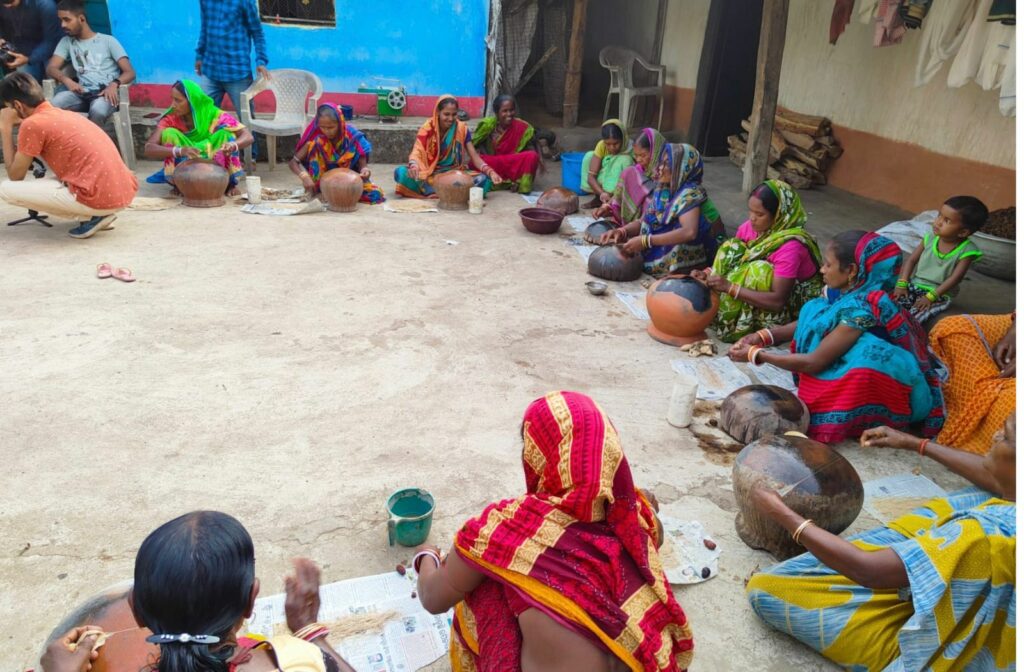Art and Craft: The Colours of Earth

Art and craft have significant relevance in human lives throughout the world and across the time.
Our ancestors belonging to primordial era used these techniques as a medium to communicate with others, entertain themselves and to bring aesthetic value in daily use products as well.
In this generation, artistry is used as an important tool in child learning methodology too. It is not only confined to cognitive development process and academic excellence rather it has therapeutic value having healing touch on mind and heart.
Looking at the stress and anxiety conditions prevailing in the highly competitive daily affairs of the present era, psychiatric doctors are prescribing their patients to be engaged in some form of art, craft and music.
This deviousness has the ability to bring out the concealed emotions of the individuals, helping the person to express it in profound manner through designs, colours, motifs, postures or sounds and facilitating the person to trade on the path of life.
The therapeutic ability of the artistry helps to nurture the soft skills among individuals like co-existing with challenges and continuous perseverance for making life better.
The endowment of artistic creation in developing a compassionate and better human being is well articulated throughout the world of current age; however our erstwhile generations have explored its other contributions too.
They have learned the technique of integration of imagination with the local available resources and daily use products along with a taste of beauty.
This created a new form of employment opportunity for masses other than the practices of agriculture that co-existed at the village level bringing together the demand and supply at the same platform imbibed in the circular economy.
The weavers, potters, stone cravers, toy makers, black smith, gold smiths etc.
who are otherwise known as artisans belongs to these community of people who integrate the local endowment with human creativity translating into utility-oriented objects of finer quality.
The raw materials for these hand made products used to be locally procured keeping in mind the sustainability aspect of resource base. Regional variation and disparity in availability of resources witnessed emergence of various artistic hand made products over a particular geographical location.
In this regard Odisha, one of the richly endowed natural resource states of India saw the evolution of multiple art based industries like handlooms and handicrafts with the progress of time since centuries.
The native royal patronage was one of the important reasons for such growth of local craftsmanship, but was not the sole factor for the booming development of handloom and handicraft industries in the state of Odisha.
The presence of waterways for inland trading and coastline advantages for maritime trade with South Asian and South East Asian countries generated extensive opportunities for these hand made products in pre-colonial periods.
The Odia trading community flourished with this trade opportunities that generated demand for more artistic craft work leading to mass employment at the village level.
Increased surge of demand for artefacts created excellence in craftsmanship that could transform ubiquitous products like sea shell, coconut shell, beetle nuts, rice, thermo cool, palm leaves, grasses, root system, metals and even sands and many more such products into piece of beauty having utility value.
One of the important aspects of these cottage industries was its vast scope of employability.
It created space for all the member of the households to be accommodated in the production process in the various stages of operation thus creating wholistic synergy effect in the manufacturing of the artefacts.
Handlooms and handicrafts coexisted with the practices of agriculture in the society, convenient for generations of sustainable livelihood models at the village level in the state of Odisha.
However, over a period of time multiple political and economic factors have pushed the demand for handiwork to the back stage thus creating hardship for the artisan community to survive.
Various innovations in the production process like automation and mechanisation, use of plastic in everyday items has drastically reduced demand of these hand made products pushing the artisans to anguish and suffer due to narrow income earning opportunity.
Currently another threat is looming large over these artisans due to drastic changes in weather conditions.
Frequent incidents of unprecedented, unpredicted big disastrous events are taking its toll on these craftsmen by destroying their limited uninsured properties, dismantling their stock as well as their asset base and ultimately pushing them to join the manual labour force to earn their livelihood.
Cyclone Fani hit the local weavers community in its hardest way generating huge loss for them along with the state exchequer.
Few lucky craftsmen who remained unharmed by these catastrophic natural events get tossed up by shrinkage of raw material base that they used to draw from the local ecosystem.
The reduced availability of basic raw material is also leading to rise in price disorient the potential buyer to purchase the creative work.
This is the most opportune time that the state must come forward to ensure the availability of raw materials as well as come up with progressive policies to mitigate the risk of the artisans as they are getting exposed to extreme climate events at regular intervals.












































